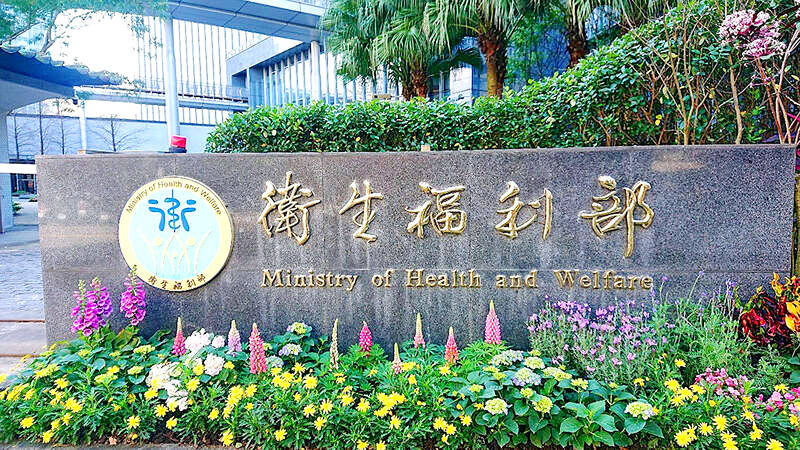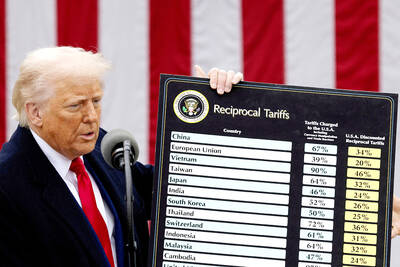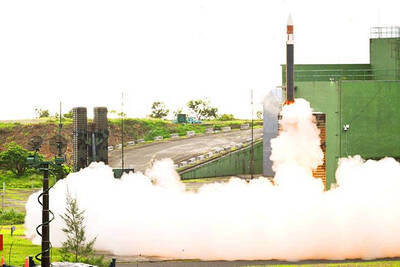Cancer topped a list of 10 leading causes of death in the nation last year for the 43rd straight year, while suicide made a comeback after a 14-year gap, the Ministry of Health and Welfare said yesterday.
There were 54,032 cancer deaths last year, with the top five types of cancers responsible for the most deaths being tracheal, bronchogenic and lung cancers, followed by liver cancer, colorectal cancer, breast cancer and prostate cancer, ministry data showed.
The total number of deaths last year was 201,383, a decrease of 4,192 from the previous year, and the overall mortality rate was 860.2 deaths per 100,000 people, 2.3 percent lower than the previous year, Department of Statistics section head Lu Shu-chun (呂淑君) said.

Photo: CNA
The figure dropped mainly due to the reduced numbers of death from COVID-19 and diabetes, she said.
The number of deaths aged 85 years or older was 61,726, accounting for 30.7 percent of all deaths and was 3.9 percent lower than the previous year, Lu said, adding that the median age at death was 77, the same as in 2023.
Cancer, heart disease, pneumonia, cerebrovascular disease and diabetes were the five leading causes of death last year, which were the same as the previous year, she said.
As COVID-19 deaths dropped from the sixth leading cause of death in 2023 to 14th last year, the following causes all moved up one place in the same order, Lu said.
The sixth to 10th leading causes were hypertensive disease, injuries from accidents, chronic lower respiratory diseases, kidney disease and suicide, she said.
The standardized mortality ratios (weighted average of the age-specific mortality rates) of the 10 leading causes all fell compared with the previous year, except for pneumonia and suicide, she said.
Regarding cancer deaths, Lu said that aside from prostate and ovarian cancers, the standardized mortality ratios all declined last year, with gastric and liver cancers registering the sharpest drop.
There were 17,259 deaths from pneumonia last year, an increase of 557 people from the previous year, and the mortality rate and standardized mortality ratio were 73.7 and 30.1 per 100,000 people respectively, she said.
Centers for Disease Control (CDC) Deputy Director-General Philip Lo (羅一鈞) said that COVID-19 was the third-leading cause of death in 2022 and sixth in 2023, but with the help of publicly funded vaccines and anti-viral drugs, the risk of severe illness and deaths from infection was effectively reduced.
However, pneumonia remained the third-leading cause of death with increased mortality, most of whom were people aged 65 or older, he said.
Some specialists attributed that to the likelihood of people with chronic illnesses being hospitalized for pneumonia at the end of a disease process, with the number likely increasing as the population ages, he said.
An analysis of the pneumonia deaths showed that most were not caused by a specific virus or bacteria, but the CDC will continue to promote personal preventive measures and implement public health intervention, he said.
The number of deaths from diabetes and kidney diseases fell by 962 and 135 respectively, Lu said.
Deaths from injuries due to accidents declined by 138, with traffic accidents accounting for 42.3 percent of the deaths, Lu said.
Department of Statistics Director Lee Chiu-yen (李秋嬿) said that suicide returned to the 10 leading causes of deaths last year after dropping out 14 years ago.
Lu said that 4,062 people died by suicide last year, up by 164 from the previous year, with the number of suicides increasing among three age groups — 15 to 24, 25 to 44 and 45 to 64 — while the number in the 14 or younger, and 65 and older, groups declined.
Department of Mental Health acting director Cheng Sheu-shin (鄭淑心) said that while the issue of increasing suicide rates is not limited to Asian countries, it is a big challenge for countries in the region, including Taiwan, Japan, South Korea, Singapore and Hong Kong, with the ratios among young and middle-aged people rising.
A previous study commissioned by the ministry on suicide risk factors in adolescents identified Internet usage, divorced parents and sleep disorders as some of the major factors, she said, adding that analyses of other age groups would be conducted.
Suicide is usually caused by multiple factors, so suicide prevention needs cross-ministerial cooperation, Cheng said.
The ministry in August last year launched a mental health program offering free counseling for people aged 15 to 45, and as of May 5, 54,508 people had used the service, Cheng said.
More than 700,000 people used the depression screening service for elderly people last year, while other government agencies have also established counseling and mental health programs, she said, encouraging people to call the ministry’s 24-hour suicide prevention hotline at 1925 when needed.

WAITING GAME: The US has so far only offered a ‘best rate tariff,’ which officials assume is about 15 percent, the same as Japan, a person familiar with the matter said Taiwan and the US have completed “technical consultations” regarding tariffs and a finalized rate is expected to be released soon, Executive Yuan spokeswoman Michelle Lee (李慧芝) told a news conference yesterday, as a 90-day pause on US President Donald Trump’s “reciprocal” tariffs is set to expire today. The two countries have reached a “certain degree of consensus” on issues such as tariffs, nontariff trade barriers, trade facilitation, supply chain resilience and economic security, Lee said. They also discussed opportunities for cooperation, investment and procurement, she said. A joint statement is still being negotiated and would be released once the US government has made

Authorities have detained three former Taiwan Semiconductor Manufacturing Co (TMSC, 台積電) employees on suspicion of compromising classified technology used in making 2-nanometer chips, the Taiwan High Prosecutors’ Office said yesterday. Prosecutors are holding a former TSMC engineer surnamed Chen (陳) and two recently sacked TSMC engineers, including one person surnamed Wu (吳) in detention with restricted communication, following an investigation launched on July 25, a statement said. The announcement came a day after Nikkei Asia reported on the technology theft in an exclusive story, saying TSMC had fired two workers for contravening data rules on advanced chipmaking technology. Two-nanometer wafers are the most

NEW GEAR: On top of the new Tien Kung IV air defense missiles, the military is expected to place orders for a new combat vehicle next year for delivery in 2028 Mass production of Tien Kung IV (Sky Bow IV) missiles is expected to start next year, with plans to order 122 pods, the Ministry of National Defense’s (MND) latest list of regulated military material showed. The document said that the armed forces would obtain 46 pods of the air defense missiles next year and 76 pods the year after that. The Tien Kung IV is designed to intercept cruise missiles and ballistic missiles to an altitude of 70km, compared with the 60km maximum altitude achieved by the Missile Segment Enhancement variant of PAC-3 systems. A defense source said yesterday that the number of

Taiwanese exports to the US are to be subject to a 20 percent tariff starting on Thursday next week, according to an executive order signed by US President Donald Trump yesterday. The 20 percent levy was the same as the tariffs imposed on Vietnam, Sri Lanka and Bangladesh by Trump. It was higher than the tariffs imposed on Japan, South Korea and the EU (15 percent), as well as those on the Philippines (19 percent). A Taiwan official with knowledge of the matter said it is a "phased" tariff rate, and negotiations would continue. "Once negotiations conclude, Taiwan will obtain a better